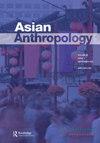墙上的文字:汉藏边境的有力铭文
Q2 Social Sciences
引用次数: 0
摘要
摘要本文考察了中国纳西少数民族地区的公共文字铭文及其在投射力量中所起的作用。中国少数民族地区的摩崖铭文可能是为了实施“文明中心”的霸权项目,该项目将汉文化视为对生活在中国边境省份的“野蛮人”的文明力量。尽管中国少数民族名义上是平等的,但汉族的语言和书写系统在中国的语言等级中占据着不可否认的特权地位。但强有力的写作并不一定来自政治控制的中心,我认为也有一些图形多元化的例子,其中的等级制度是颠倒的。在云南省白帝纳西族小镇的一个洞穴墙上发现的涂鸦就是一个强有力的、非正式的公共文本行为的例子。最有力和最负盛名的涂鸦铭文是用纳西族文字书写的。对这些铭文的分析可能有助于揭示在异质环境中书写的社会含义,表明在墙上书写纳西铭文的仪式行为是如何灌输纳西价值观的,并表明中国的语言等级制度并非一成不变。本文章由计算机程序翻译,如有差异,请以英文原文为准。
Writings on the wall: powerful inscriptions in the Sino-Tibetan borderlands
Abstract This article investigates public textual inscriptions in China’s Naxi minority region and the role they play in projecting power. Cliff inscriptions in Chinese minority areas may be an attempt to enforce the hegemonic project of the “civilizing centre,” which sees Han culture as a civilizing force on the “barbarians” that live in China’s border provinces. Despite the nominal equality of China’s ethnic minority groups, the language and writing system of the Han majority occupy an undeniably privileged position in the country’s linguistic hierarchy. But powerful writing does not necessarily have to emanate from the centre of political control, and I argue that there are examples of graphic pluralism where the hierarchy is upturned. One such example of powerful, informal public text acts are the graffiti found on the walls of a cave in an ethnically Naxi township of Baidi in Yunnan province. The most powerful and prestigious graffiti inscriptions are those that are written in the native Naxi logographic script. An analysis of these inscriptions may help to reveal the social implications of writing in heterographic situations, showing how the ritual act of writing Naxi inscriptions on the wall inculcates Naxi values and suggests that China’s linguistic hierarchy is not immutable.
求助全文
通过发布文献求助,成功后即可免费获取论文全文。
去求助
来源期刊

Asian anthropology
Social Sciences-Anthropology
CiteScore
1.60
自引率
0.00%
发文量
25
期刊介绍:
Asian Anthropology seeks to bring interesting and exciting new anthropological research on Asia to a global audience. Until recently, anthropologists writing on a range of Asian topics in English but seeking a global audience have had to depend largely on Western-based journals to publish their works. Given the increasing number of indigenous anthropologists and anthropologists based in Asia, as well as the increasing interest in Asia among anthropologists everywhere, it is important to have an anthropology journal that is refereed on a global basis but that is editorially Asian-based. Asian Anthropology is editorially based in Hong Kong, Taiwan, and Japan, but welcomes contributions from anthropologists and anthropology-related scholars throughout the world with an interest in Asia, especially East Asia as well as Southeast and South Asia. While the language of the journal is English, we also seek original works translated into English, which will facilitate greater participation and scholarly exchange. The journal will provide a forum for anthropologists working on Asia, in the broadest sense of the term "Asia". We seek your general support through submissions, subscriptions, and comments.
 求助内容:
求助内容: 应助结果提醒方式:
应助结果提醒方式:


